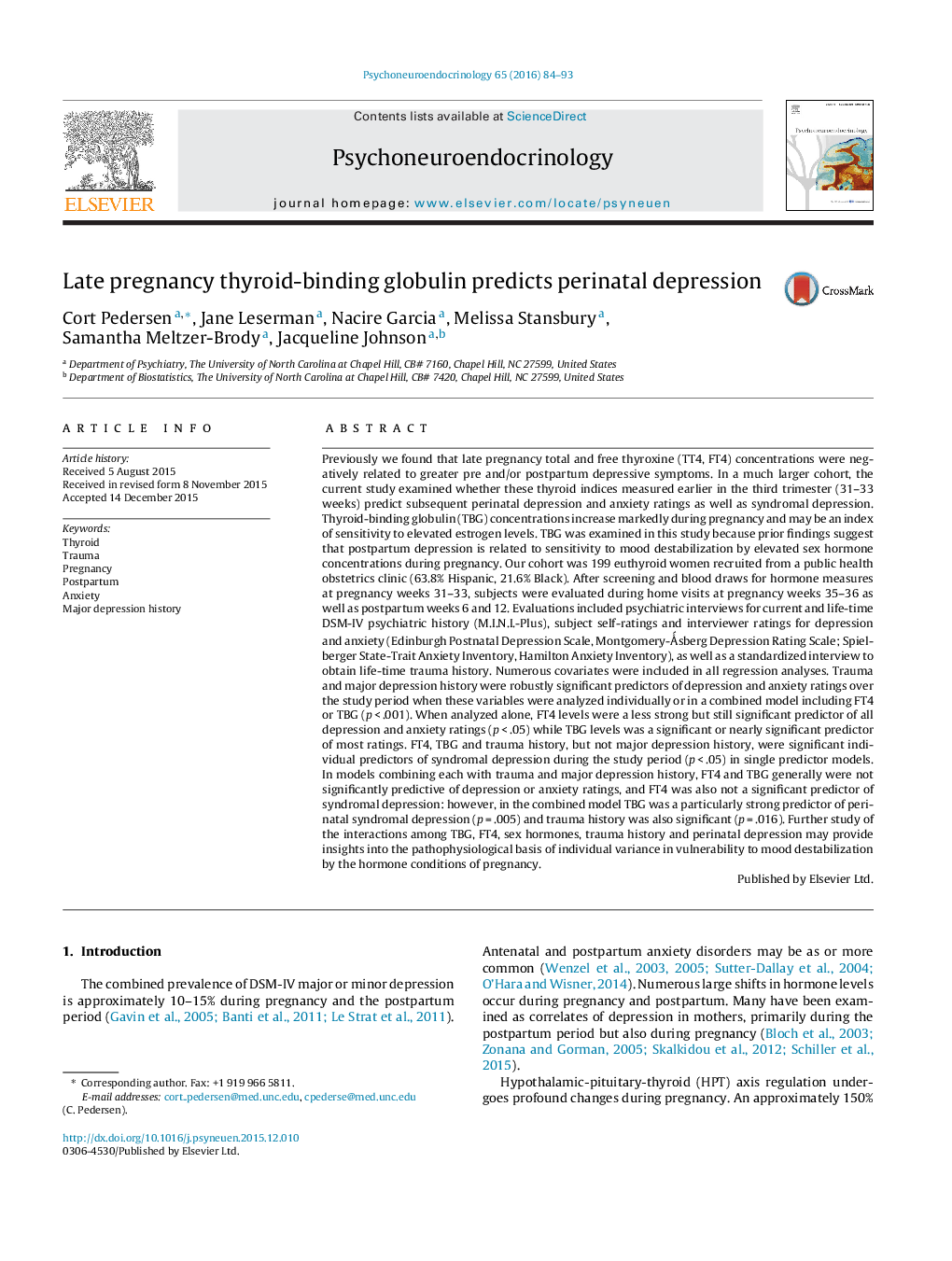| کد مقاله | کد نشریه | سال انتشار | مقاله انگلیسی | نسخه تمام متن |
|---|---|---|---|---|
| 6818340 | 547073 | 2016 | 10 صفحه PDF | دانلود رایگان |
عنوان انگلیسی مقاله ISI
Late pregnancy thyroid-binding globulin predicts perinatal depression
ترجمه فارسی عنوان
تداخل ترویج گلوبولین در دوران بارداری در آینده، افسردگی پرناتال را پیش بینی می کند
دانلود مقاله + سفارش ترجمه
دانلود مقاله ISI انگلیسی
رایگان برای ایرانیان
کلمات کلیدی
تیروئید، تروما بارداری، پس از زایمان، اضطراب، تاریخچه افسردگی عمده،
موضوعات مرتبط
علوم زیستی و بیوفناوری
بیوشیمی، ژنتیک و زیست شناسی مولکولی
علوم غدد
چکیده انگلیسی
Previously we found that late pregnancy total and free thyroxine (TT4, FT4) concentrations were negatively related to greater pre and/or postpartum depressive symptoms. In a much larger cohort, the current study examined whether these thyroid indices measured earlier in the third trimester (31-33 weeks) predict subsequent perinatal depression and anxiety ratings as well as syndromal depression. Thyroid-binding globulin (TBG) concentrations increase markedly during pregnancy and may be an index of sensitivity to elevated estrogen levels. TBG was examined in this study because prior findings suggest that postpartum depression is related to sensitivity to mood destabilization by elevated sex hormone concentrations during pregnancy. Our cohort was 199 euthyroid women recruited from a public health obstetrics clinic (63.8% Hispanic, 21.6% Black). After screening and blood draws for hormone measures at pregnancy weeks 31-33, subjects were evaluated during home visits at pregnancy weeks 35-36 as well as postpartum weeks 6 and 12. Evaluations included psychiatric interviews for current and life-time DSM-IV psychiatric history (M.I.N.I.-Plus), subject self-ratings and interviewer ratings for depression and anxiety (Edinburgh Postnatal Depression Scale, Montgomery-Ǻsberg Depression Rating Scale; Spielberger State-Trait Anxiety Inventory, Hamilton Anxiety Inventory), as well as a standardized interview to obtain life-time trauma history. Numerous covariates were included in all regression analyses. Trauma and major depression history were robustly significant predictors of depression and anxiety ratings over the study period when these variables were analyzed individually or in a combined model including FT4 or TBG (p < .001). When analyzed alone, FT4 levels were a less strong but still significant predictor of all depression and anxiety ratings (p < .05) while TBG levels was a significant or nearly significant predictor of most ratings. FT4, TBG and trauma history, but not major depression history, were significant individual predictors of syndromal depression during the study period (p < .05) in single predictor models. In models combining each with trauma and major depression history, FT4 and TBG generally were not significantly predictive of depression or anxiety ratings, and FT4 was also not a significant predictor of syndromal depression: however, in the combined model TBG was a particularly strong predictor of perinatal syndromal depression (p = .005) and trauma history was also significant (p = .016). Further study of the interactions among TBG, FT4, sex hormones, trauma history and perinatal depression may provide insights into the pathophysiological basis of individual variance in vulnerability to mood destabilization by the hormone conditions of pregnancy.
ناشر
Database: Elsevier - ScienceDirect (ساینس دایرکت)
Journal: Psychoneuroendocrinology - Volume 65, March 2016, Pages 84-93
Journal: Psychoneuroendocrinology - Volume 65, March 2016, Pages 84-93
نویسندگان
Cort Pedersen, Jane Leserman, Nacire Garcia, Melissa Stansbury, Samantha Meltzer-Brody, Jacqueline Johnson,
